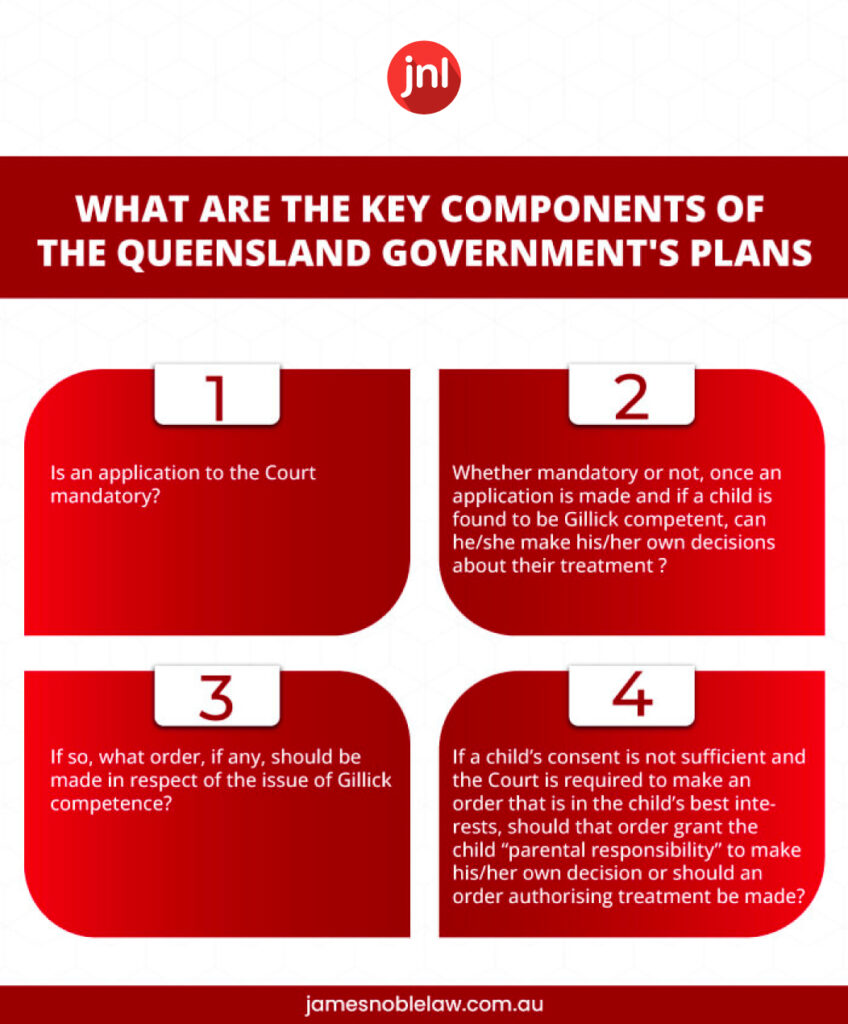
What is Gender dysphoria?
 A concept designated as clinically significant distress or impairment related to a strong desire to be of another gender, which may include a desire to change primary and/or secondary sex characteristics. Not all transgender or gender diverse people experience dysphoria.
A concept designated as clinically significant distress or impairment related to a strong desire to be of another gender, which may include a desire to change primary and/or secondary sex characteristics. Not all transgender or gender diverse people experience dysphoria.
Gillick competent:
The legal test is used to determine if a child is capable of giving consent when he or she “achieves a sufficient understanding and intelligence to enable the child to understand fully what is proposed”. This is referred to as ‘Gillick competent’ or a ‘mature minor’.
 Is an application to the Court mandatory?
Is an application to the Court mandatory?- Whether mandatory or not, once an application is made and if a child is found to be Gillick competent, can he/she make his/her own decisions about their treatment?
- If so, what order, if any, should be made in respect of the issue of Gillick competence?
- If a child’s consent is not sufficient and the Court is required to make an order that is in the child’s best interests, should that order grant the child “parental responsibility” to make his/her own decision or should an order authorising treatment be made?
Gender Dysphoria is a term that describes the distress experienced by a person due to incongruence between their gender identity and their gender assigned at birth. The description of Gender Dysphoria in the American Psychiatric Association, Diagnostic and Statistical Manual of Mental Disorders: DSM-5 Fifth Edition is in two parts. Part A sets out six manifestations of marked incongruence, two of which must be present for at least six months. Part B requires the incongruence to be associated with clinically significant distress or impairment in social, occupational or other important areas of functioning.
The Australian Standards provide that the optimal model of care for trans and gender diverse adolescents who present to services involves a coordinated, multidiscipline team approach. This may include clinicians with experience in the disciplines of child and adolescent psychiatry, paediatrics, adolescent medicine, paediatric endocrinology, clinical psychology, gynaecology, andrology, fertility services, speech therapy, general practice and nursing.
Gender dysphoria treatment

The Australian Standards describe stage 1 Gender dysphoria treatment as ‘puberty suppression’ which typically relieves distress for trans adolescents by halting progression of physical changes such as breast growth in trans males and voice deepening in trans females. In Australia, gonadotrophin-releasing hormone analogues are available in subcutaneous and intramuscular injectable preparations.
The Australian Standards claim that the effects of puberty suppression is reversible whilst acknowledging both that the main concern relates to the impact upon bone mineral density and that the long term impact on bone mineralization is currently unknown.
The Australian Standards describe stage 2 treatment as gender-affirming hormone treatment using oestrogen and testosterone and notes some of the effects of this medication are irreversible (such as breast growth), whilst others are unknown (such as decreased sperm production).
The Australian Standards provide guidelines for surgical interventions for trans and gender diverse adolescents. In its guidelines to health professionals, the Australian Standards make an incorrect assertion about the current state of the law. The Australian Standards state, “current law allows adolescent’s clinicians to determine their capacity to provide informed consent for treatment. Court authorization prior to commencement of hormone treatment is no longer required”. The guidelines say that informed consent from parents/legal guardians should be obtained in relation to puberty in relation to the commencement of gender-affirming hormone treatment. The Australian Standards say although obtaining consent from parents/guardians for commencement of hormone treatment is ideal, parental consent is not required when the adolescent is considered to be competent to provide informed consent. The effect is that the Australian Standards incorrectly state the current law in relation to the need for the consent of parents/guardians to stage 2 treatment. The statements in the Australian Standards do not accurately reflect current Full Court authority in circumstances where there is a dispute about treatment
Rise in cases
There has been an exponential rise in adolescent referral to gender clinics in the last decade.
The rise in referrals may be largely due to developments in society and in medicine, leading to greater awareness and understanding, and lessening of stigma associated with gender issues and trans identity. An additional factor is the increased availability of appropriate and accessible services.
The Royal Australian College of Physicians noted that trans and gender diverse children and adolescents are a very vulnerable population, experiencing stigma and extremely high rates of depression, self-harm, attempted suicide and completed suicide. Importantly, the College described Gender Dysphoria treatment as an emerging area of healthcare where existing evidence on health and wellbeing outcomes of clinical care is limited due to the relatively small number of studies, the small size of study populations, the absence of long-term follow-up, and the ethical challenges of robust evaluation when control (no treatment) is not acceptable. The College relevantly observes that similar limitations on the existing evidence of healthcare apply to other conditions which affect small segments of the population, such as rare cancers. The College expressed the view that addressing gaps in the evidence base is important, although notes that further scientific evidence may take a considerable period of time to produce.
The College supported the principles underlying the Australian Guidelines, and specifically the emphasis on the multidisciplinary approach to providing person-centered care which priorities the best interests, preferences and goals of the child or adolescent. The College recommends that treatment should be holistic, developmentally informed, child-centered, and individualised. In order to facilitate a higher level of informed consent, the College recommends that patients and families must be provided with information about the limitations of the available evidence regarding Gender Dysphoria and there should be informed discussion of the burdens and benefits of treatment and options in a way each child or adolescent can understand.
APPLICABLE LEGAL PRINCIPLES
Why is the finding of Gillick competence of an adolescent not determinative, if parents do not agree about treatment?
 Current Full Court authorities provide that, if the Court is called upon (by way of mandatory application or one that was not mandatory) to determine a controversy about treatment, the Court should not merely resolve that controversy by making a finding or determination about Gillick competence, but go on to make an order to authorise treatment having regard to the best interests of the child as the paramount consideration (including taking into account but not being bound by the child’s consent). That argument is based upon a reading of the relevant passages from Re Jamie and Re Kelvin.
Current Full Court authorities provide that, if the Court is called upon (by way of mandatory application or one that was not mandatory) to determine a controversy about treatment, the Court should not merely resolve that controversy by making a finding or determination about Gillick competence, but go on to make an order to authorise treatment having regard to the best interests of the child as the paramount consideration (including taking into account but not being bound by the child’s consent). That argument is based upon a reading of the relevant passages from Re Jamie and Re Kelvin.
In Re Jamie, Bryant CJ said at [140]: If there is a dispute about whether treatment should be provided (in respect of either stage one or stage two), and what form treatment should take, it is appropriate for this to be determined by the court under s 67ZC.
If the child is Gillick competent, then the child can consent to the treatment and no court authorisation is required, absent any controversy.
The question of whether a child is Gillick competent, even where the treating doctors and the parents agree, is a matter to be determined by the court.
If there is a dispute between the parents, child and treating medical practitioners, or any of them, regarding the treatment and/or whether or not the child is Gillick competent, the court should make an assessment about whether to authorise stage two having regard to the best interests of the child as the paramount consideration. In making this assessment, the court should give significant weight to the views of the child in accordance with his or her age or maturity.
That in circumstances where there is a disagreement in relation to proposed treatment between the parents and/or their child or with the child’s treating doctors, an application to the court will be necessary
If the court was completely satisfied of the child’s capacity to consent to stage two treatment, it would be unnecessary for it to have to authorise the treatment. That could be left to the child. But if the court had any doubt about that capacity, then it would have to determine for itself the question of whether the stage two treatment should be authorised
Any court authorisation for that treatment is a departure from the exercise of a right and responsibility ordinarily vested in parents. Of course, routine treatments for everyday medical conditions embrace that parental right and responsibility and do not require court authorisation. However, other
circumstances may dictate the need for court intervention. For example, disputes between parents or experimental or novel treatment or treatment for unusual or novel conditions can present difficulties; those circumstances may require a determination by a court of the best interests of the relevant child, in other words by a source other than those who would usually be regarded as being “in the best position to act in the best interests of the child”
Whether the treatment should be administered; e.g., if the parents or the medical professionals are unable to agree. There is no doubt that the Court has the jurisdiction and the power to address issues such as those.
The existing law is that any treating medical practitioner seeing an adolescent under the age of 18 is not at liberty to initiate stage 1, 2, or 3 treatments without first ascertaining whether or not a child’s parents or legal guardians consent to the proposed treatment. Absent any dispute by the child, the parents, and the medical practitioner, it is a matter of the medical professional bodies to regulate what standards should apply to medical treatment. If there is a dispute about consent or treatment, a doctor should not administer stage 1, 2, or 3 treatments without court authorisation.
Court Proceedings
Court proceedings deal directly with the child’s identity and traverse matters which are very personal to the child.
Accordingly, participants and observers are limited to the parties and their lawyers and not open to members of the public or the media.
Need Legal Help?
If you need help, please contact the Brisbane Family lawyers team at James Noble Law today for a FREE, no-obligation 20-minute consultation. To schedule an appointment with one of our Qualified and experienced Family lawyers Brisbane.
Find Brisbane family lawyers on Google Maps near you.
Helpful Family Law Documents & Guides
- A Guide to Children Negotiation and Family Law
- A Guide to Property & Family Law Act Paper
- A Guide to Alternative Dispute Resolutions
- A Guide to Preparing for the unthinkable
- A Guide to Collaborative Practice Paper
- A Guide to Separation in Family Law
- A Guide to Family Law Property
- A Guide to Dispute Resolution
- A-Z Collaborative Law eBook
- A Guide to Separation
- A Guide to Children
- Arbitration eBook


 Is an application to the Court mandatory?
Is an application to the Court mandatory?